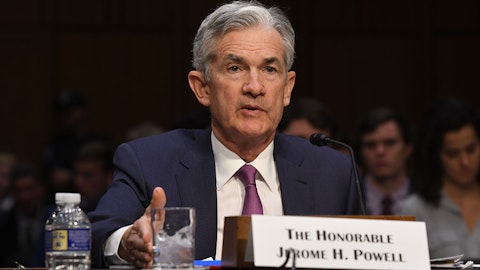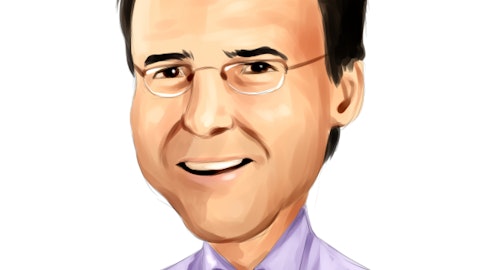OneMain Holdings, Inc. (NYSE:OMF) Q4 2022 Earnings Call Transcript February 7, 2023
Operator: Welcome to OneMain Financial Fourth Quarter and Full Year 2022 Earnings Conference Call and Webcast. Hosting the call today from OneMain is Peter Poillon, Head of Investor Relations. Today’s call is being recorded. At this time, all participants have been placed in a listen-only mode, and the floor will be open for your questions, following the presentation. It is now my pleasure to turn the floor over to Peter Poillon. You may begin.
Peter Poillon: Thank you, Gretchen. Good morning, everyone, and thank you for joining us. Let me begin by directing you to page 2 of the fourth quarter 2022 investor presentation, which contains important disclosures concerning forward-looking statements and the use of non-GAAP measures. The presentation can be found in the Investor Relations section of our website. Our discussion today will contain certain forward-looking statements reflecting management’s current beliefs about the company’s future, financial performance and business prospects and these forward-looking statements are subject to inherent risks and uncertainties and speak only as of today. Factors that could cause actual results to differ materially from these forward-looking statements are set forth in our earnings press release.
We caution you not to place undue reliance on forward-looking statements. If you may be listening to this via replay at some point after today, we remind you that the remarks made herein are as of today February 7th and have not been updated subsequent to this call. Our call this morning will include formal remarks from Doug Shulman, our Chairman and Chief Executive Officer; and Micah Conrad our Chief Financial Officer. After the conclusion of our formal remarks, we will conduct a question-and-answer session. Let me turn the call over to Doug.
Doug Shulman: Thanks, Pete, and good morning everyone. Thank you for joining us today. I’d like to start today’s call by providing a brief overview of some of our accomplishments in 2022. And then I’ll cover our performance for the fourth quarter, the current credit and macroeconomic environment and discuss our key strategic initiatives. As you all know inflation started to impact delinquency levels for many non-prime consumers in the second quarter. We demonstrated our agility by quickly pivoting our credit posture and operations. On credit, we significantly tightened our credit box over the summer and our new originations are performing as expected. Operationally, we pivoted more of our team to collections and to supporting customers who are having difficulty making ends meet.
The result is that for the last two quarters, we have seen stabilization of our credit results. Despite a significantly tightened credit box through much of the year, we originated $13.9 billion of loans and served over 2.6 million customers in 2022. This highlights our commitment to serving hard-working Americans in good times and in bad and also underscores the strength of our balance sheet. We had plenty of access to funding even in a very difficult year in the capital markets and in the bond markets in particular. We made significant progress in 2022 building out our credit card and new secured lending distribution channels, both of which will drive significant growth in the year ahead. And through this very difficult environment, we generated almost $1.1 billion of capital demonstrating the incredible business model we have built over the years.
We also made significant progress in our ongoing commitment to be a socially responsible company, highly focused on our customers, communities and employees. We rolled out Trim, our money saving and financial wellness platform to all of our customers in 2022, as we continue to help our customers improve their financial well-being. We launched Credit Worthy by OneMain in thousands of high schools across the country. We issued a first of its kind social ABS fund, highlighting our mission to helping hard-working Americans make progress to a better future. And we made a $50 million deposit commitment to support minority depository institutions and military veterans. Last week, we were informed that OneMain has been included in MorningStar’s Sustainalytics Top Rated ESG Companies List for 2023, ranking in the top 10% of rated companies in the Diversified Financials Industry category.
OneMain was also named to America’s 100 Most Loved Workplaces for 2022 by Newsweek. Together, these accolades showcase our deep commitment to our team members who serve our customers so well every day and to the communities in which we work. Now let me provide a brief overview of the quarter. We had capital generation of $233 million in the quarter and demand for loan products remained strong. Originations totaled $3.5 billion in the quarter. Even with the significant tightening actions, we took earlier this year. Considering our more conservative underwriting posture, we’re really pleased with the volume of originations, as well as the overall credit quality. Our 6% year-over-year receivables growth was supported by our expanded products and distribution channels.
Our 30 to 89 delinquency levels finished the quarter at 3.07%. This is in line with normal seasonal trends. We are optimistic about this continued stabilization and credit performance, following our quick pivots last year. Net charge-offs in the quarter were 6.9%, also within our expectations and were aided by good performance in our later stage collections and strong post charge-off recoveries. Regarding the macroeconomic environment as well as the non-prime consumer, we’re encouraged by the continued strong employment numbers. However, elevated levels of inflation are impacting consumers, particularly those at the lower end of the credit spectrum. We remain highly focused on supporting our customers, especially those most pressured by inflation.
We have several advantages that allow us to better serve our customers and set us apart from the competition. They include our community-based branch network that keeps us close to our customers, so we can work with each of them based on their own individual circumstances. Our long history serving the non-prime consumer through economic cycles, and this includes our proprietary data as well as our strong credit and data science teams and models. And we have an incredibly strong balance sheet, which we positioned with a long liquidity runway and staggered maturities exactly for times like this. The data that we analyze shows that we are performing quite well in comparison to other nonprime lenders. And you can see that illustrated on Slide 10 of our presentation.
We continue to have a very conservative underwriting posture. Today we are only making loans that will meet our return hurdles even if the macroeconomic environment worsens. Notwithstanding, our current conservative credit box, we expect to continue to grow our balance sheet in the year ahead. We expect growth in 2023 to continue to come from higher credit quality customers along with growth from credit card and new distribution channels. To better illustrate the point on improved credit quality, I’ll point out that our top two risk grades those with the best credit quality and lowest risk customers make up about 60% of our new customer originations today versus just 37% in mid-2021. Let me now spend a few minutes on strategic initiatives. Our top focus is managing our credit and balance sheet through this complex macroeconomic environment.
But we also continue to focus on strategic initiatives that will fuel growth and profitability over the medium and long-term. We continue to close about half of our loans outside of a branch, engaging customers through our mobile application, website, text, screen share, phone and more. We also have advanced our mobile and two-way tech strategies and now have the ability to digitally engage with customers in collections, payments and servicing. We are confident that our omni-channel strategy leveraging the best of digital phone and in-person interactions will advance our competitive position. On new products, we continue to make excellent progress in our digital-first BrightWay credit card. During the holiday season, we saw customers regularly reach for our card to spend on holiday purchases.
We’re now seeing many of our early customers hitting on-time payment milestones at which point they can choose to lower their APR or increase their credit line. The overwhelming majority of our customers are engaging directly through our mobile app. We continue to closely analyze the performance of our cards across a number of metrics like spend volume, balance build, revolve rates and most importantly credit. Even as we maintain a conservative credit posture, we see a lot of opportunity to grow our card portfolio. At year-end, we had approximately 135,000 card customers and $107 million of card receivables. We’re going to continue to scale this business in profitable segments, and we remain confident that our credit card business will drive meaningful growth with excellent returns in the future.
This year as we scale the credit card business, it will have a mild drag on capital generation before expecting it to turn positive in 2024. In 2025 and beyond, we expect the business will be quite profitable and begin meaningfully contributing to our capital generation growth. We also continue to see excellent results from our efforts to expand distribution channels in our secured lending business, which grew to nearly $400 million of receivables in 2022. Let me end by touching on capital allocation. Our top priority is always investment in our business; first to underwrite high-quality loans that meet our return hurdles; and second, continued investment in the initiatives that will drive excellent capital generation growth in the future. We will also continue to return capital to shareholders.
This morning, we announced an increase to our quarterly dividend by more than 5% to $1 or $4 annually. This translates to a yield of approximately 9% at our current share price. Even in a difficult economic environment, our business has strong capital generation and we are committed to a healthy dividend level. During the fourth quarter we repurchased 1.6 million shares bringing the full year repurchase to $7.2 million or about 5.5% of shares outstanding at the beginning of the year. With that, let me turn the call over to Micah to take you through the financial results of the fourth quarter.

Andrey_Popov/Shutterstock.com
Micah Conrad: Thanks, Doug and good morning, everyone. Our conservative underwriting costs here combined with a company-wide focus on supporting our customer results is helping to deliver strong financial results. Fourth quarter net income was $180 million or $48 per diluted share down from $2.02 per diluted share in the fourth quarter of 2021. C&I adjusted net income was $191 million or $1.56 per diluted share down from $2.38 per diluted share in the prior year quarter. Both variances reflect an increase in provision expense from the stimulus-driven historic lows we experienced in 2021. Capital generation was strong at $233 million in the fourth quarter and came in at $1.70 billion for the full year. Managed receivables reached $20.8 billion up $1.1 billion or 6% from a year ago.
Interest income was $1.1 billion flat to the prior year quarter as higher average receivables were offset by lower portfolio yield. Yield in the fourth quarter was 22.3% down 100 basis points year-over-year reflecting higher 90-plus delinquency and the impacts of payment assistance we are providing to customers where needed. We expect first quarter 2023 yield to be around the same level as 90-plus generally reaches normal seasonal highs in February. We then expect to see a gradual improvement during the year as 90-plus seasonally declines to its natural low in the summer and the impacts of our credit tightening begin to show through. Pricing on new originations remains above 2021 levels as we continue to monitor the competitive environment and opportunistically take positive actions to offset the impact of a tighter credit box.
We expect that current pricing will support portfolio yield in the future as new originations become a bigger part of our portfolio and the current macroeconomic impacts subside over time. Interest expense was $230 million in the quarter, down $3 million or 1% versus the prior year. Interest expense, as a percentage of average receivables, was 4.6% this quarter, down from 4.9% a year ago, a result of the proactive actions we’ve taken to manage our funding profile over the last several years. As you know, we’ve been extending and staggering our maturities and therefore current higher issuance rates did not meaningfully impact 2022 interest expense. Looking forward, we estimate that about 90% of our average debt for 2023 is already on the books at fixed rates.
And if you want to look a little further out to 2024, it’s about 80%. This is what gives us confidence in projecting very modest increases to interest expense ahead. Other revenue was $168 million in the fourth quarter, up $7 million or 4% from the prior year quarter. The increase was primarily associated with higher yields on our $2 billion investment portfolio. Provision expense was $404 million, including current period net charge-offs of $348 million and a $56 million increase to our allowance. About half of the allowance build was from growth in receivables, with the remainder reflecting a modest increase in our reserve ratio to 11.6% as we remain cautious about the macroeconomic environment. Policyholder benefits and claims expense for the quarter was $34 million, down from $50 million in the fourth quarter of 2021.
The reduction was driven by adjustments to our claims reserves due to lower loss experience. We anticipate claims expense to return to more normal levels over the coming quarters. Originations were $3.5 billion in the fourth quarter, down from $3.8 billion in the fourth quarter of 2021, primarily a result of our tighter underwriting posture. Managed receivables grew $300 million sequentially on the strength of solid consumer demand, a positive competitive environment and continued growth from credit cards and new distribution channel partnerships. Please note, managed receivables of $20.8 billion includes $766 million of receivables sold through our forward flow arrangements and $107 million of credit card balances. As Doug mentioned we continue to see positive results from our credit card rollout and we expect card receivables to be between $400 million and $500 million by the end of 2023.
While this rollout will create a small drag on capital generation this year, we anticipate capital generation will turn positive late this year or in early 2024. And as you know, CECL requires maintenance of lifetime loss reserves and so you should expect to see us building reserves as we scale the business. Let’s turn to our credit trends, highlighted on slide nine. 30 to 89 delinquency was 3.07% in the fourth quarter, up from 2.81% in the third quarter. Since we first reported an elevated level of 30 to 89 delinquency in the second quarter of 2022, performance has generally followed expected seasonal patterns. From second to fourth quarter, 30 to 89 delinquency increased 34 basis points this year, as compared to approximately 30 basis points in 2018 and 2019.
If seasonal patterns continue, we should see improved performance in the first quarter, as payments typically increase during the tax refund season. Our January 30 to 89 results were in line with these seasonal patterns, declining a few basis points from December levels. Loan net charge-offs were $344 million or 6.9% for the quarter. Full year net charge-offs came in at the low-end of our guidance at 6.1%. Net charge-offs continue to be supported by strong recoveries which were 1.2% of average receivables in the quarter. Recoveries remain above pre-pandemic levels of approximately 0.9%, driven by a strategic investment to bring this activity in-house combined with opportunistic sales. I wanted to draw your attention to slide 11, of our deck.
As you know we’ve been gradually tightening our credit box since late 2021. However the most significant adjustment we’ve made over the last year was in early August 2022. On the left side of the page, we show an estimate of how we expect receivables concentration to change over the coming quarters, between loans originated pre-tightening and those originated post tightening. On the right side of the page, we show the performance of those post tightening vintages for which we have at least three months of data. As you can see the vintages are performing in line with pre-pandemic levels and these vintages are expected to have more influence in our portfolio results as we get into the back half of this year. We anticipate that by year-end 2023 approximately 70% of our book will be from loans originated since that major August tightening.
Turning to slide 12, fourth quarter operating expenses were $367 million, up 5% year-over-year. Full year operating expense was $1.4 billion and operating leverage for the year was 7.1%, down from 7.3% in 2021 and down from 7.5% in 2019. Slide 13 looks at our expense trends over the last few years, and our expectation for the year ahead. You will see on this slide that we’ve maintained core expense within a very tight range over the past four years with 2022 expense coming in below 2019 levels. That is despite, mid-teens growth in average receivables over the same period. In 2023, we expect core expenses to grow very modestly, in the 2% to 3% range. We also plan to invest an additional $50 million for growth, mainly in cards and distribution channels as we continue to scale those businesses.
With that said, we expect an operating expense ratio that is very much in line with what you’ve come to expect from us, about 7.1% in 2023. That’s flat to 2022 and down from historic levels. Let’s now turn to slide 14 for an update on our balance sheet and funding. Funding markets remain quite challenged in the fourth quarter, and it is during these times that a strong balance sheet and a mature sophisticated funding program like ours is a significant advantage. In December, we completed an $800 million ABS issuance with an average coupon of 6%. We once again we saw strong support from returning investors, while also attracting some new investors to our program. Despite the market challenges, 2022 was overall a very productive year for OneMain.
We raised $3 billion of market funding with an average coupon of about 5%, including issuing a first-of-its-kind social ABS in April. We also completed a $350 million, three-year private funding deal with one of our long-standing bank partners. We continue to enhance our already strong liquidity profile adding $400 million to our committed bank capacity which totaled $7.4 billion at year-end. We renewed seven secured lines during the year and we added three banks to our unsecured corporate revolver which now totals $1.25 billion. I’m also pleased to say that in December we renewed our inaugural loan sale partnership through the end of 2023. We did so at the same level of purchases $75 million per quarter and at similar economics to our original agreement.
This agreement demonstrates the confidence our partners have in OneMain. Rounding out the balance sheet our net leverage remained within range at 5.5 times down from 5.6 times in 3Q. On slide 16, we’ve provided some expectations for 2023. Please note these estimates assume a relatively stable macroeconomic environment. And should the environment change, we will update our expectations accordingly. We expect managed receivables to grow in the low to mid-single-digits. This assumes we maintain our current credit box for all products and see continued growth in our distribution channel partnerships and our credit card. Loan net charge-offs for the year are expected to be 7% to 7.5% and we expect to see normal seasonal patterns resume. We anticipate first half charge-offs to be above the full year range with second half expected to be below.
First half losses are typically seasonally higher and will reflect the elevated delinquency we saw in the second half of 2022. We expect charge-offs to improve in the second half, in line with normal seasonal trends and as our current underwriting becomes a bigger part of our receivables. And as I discussed earlier, we expect operating leverage to be roughly flat to 2022 at approximately 7.1%. With that, I’d like to turn the call back to Doug.
Doug Shulman: Thanks Micah. The 2022 accomplishments that I highlighted at the beginning of this call demonstrates our ability to thrive in any market environment. As we look ahead, we feel really good about how our business is positioned. We’re actively managing our underwriting and have seen credit performance stabilize over the last two quarters and the business we are booking today is performing in line with expectations. Our balance sheet, which we positioned with a long liquidity runway just for difficult markets like today, allows us to book all of the good business that we see and the foundation we are saying with our strategic initiatives including credit card and new distribution channels will drive capital generation growth whenever we merge out of this uncertain environment.
We will remain alert and agile as the economic picture evolves and are prepared to adjust our credit box to drive the best possible results for our shareholders. Finally, I just want to take a moment to thank all of our OneMain team members who come to work every day to make a difference for our customers, our communities, and our shareholders. With that, let me turn the call over to the operator and we’re happy to take your questions.
See also 25 Least Developed Countries in Europe and Top 20 Financial Cities in the World.
Q&A Session
Follow Onemain Holdings Inc. (NYSE:OMF)
Follow Onemain Holdings Inc. (NYSE:OMF)
Operator: The floor is now open for questions. Our first question is coming from Moshe Orenbuch from Credit Suisse.
Moshe Orenbuch: Yes. Thanks, Doug and Micah and Doug, I appreciate that comment at the end about being prepared to adjust the credit box. Maybe could you just talk a little bit about obviously, your guidance you’d like it to be to some degree on the conservative side. When you think about the environments, what you talked about in terms of your advantages in funding and some of the tightening that you’re seeing kind of above you, what are the sorts of things that might happen to make that — your growth better, or in fact kind of less good than would be in that guide range?
Douglas Shulman: Yes. No, thanks, Moshe. We still have quite, an uncertain economic picture. I think which everybody knows. It’s a tricky environment to operate in. Unemployment has been a real bright spot, but inflation is still impacting our customers. And as you mentioned Moshe, we’re seeing in our recent vintages since we tightened our credit box they’re performing very good. Our basic operating principle is, we want to be careful stewards of our shareholders’ capital. And so right now, we may have a tighter box than needed. But given the uncertainty in the environment, we’re being quite careful. So, if we have room in our current box we talked about it before for unemployment to tick up, meaning, we’ve already incorporated in the business we’re underwriting to both the stress we saw in our book in 2022, plus deterioration in the macro environment.
And so said another way, the business we’re booking today are going to meet our return hurdles even if we see some stress. And so, if we see continued stabilization, if we see a few more months of the new vintages we’re booking, performing as expected. If we see some of the clouds lift from the economic environment it feels a little less uncertain, we could open up our box, then we could have growth above where we said. But if there’s a sudden quick move in unemployment and things go south in the economy, we could tighten up our box. And so, it’s a very difficult year to give guidance because of the uncertainty. What we’re doing is, being very careful with our balance sheet, being very careful with our underwriting and making sure we are investing for the future growth of the company whenever things become less uncertain.
Moshe Orenbuch: Great. And thanks for that. And certainly appreciate all of those difficulties. Given what you had mentioned that the levels of unemployment, but the bigger factor on your customers being the increase in inflation. Are there any signs of kind of that — the inflation in goods kind of decelerating relative to the inflation in wages in your specific customer base? And if so, how do you think that will impact you over the course of 2023?
Douglas Shulman: Very hard to pinpoint like the exact movements in inflation and goods versus services. Obviously, deceleration of inflation in goods, means people have more disposable income because things cost less, but deceleration in services can also mean less income. And so it’s very hard to pinpoint in the short-term exactly in our customer base. What I will tell you is and you can see from our delinquency trends, things have stabilized. We saw a spike in delinquency in the second quarter of 2022. The last couple of quarters we’ve seen good stabilization and our new originations albeit with a tighter credit box are performing spot on where we thought they would. And so if inflation keeps stabilizing and going down and unemployment stays low, I think we’ll be in very good shape. But again, we got to just keep an eye on it. It will play itself out.
Moshe Orenbuch: Got it. Thanks very much.
Operator: Our next question comes from Vincent Caintic from Stephens.
Vincent Caintic: Good morning. Thanks for taking my question. First question Doug and Micah the and maybe taking a step back and just kind of looking at the path to normalization here. If we look at what’s already happened, we’ve had kind of two tightenings with underwriting and then the customer maybe hasn’t we haven’t officially gone through a recession yet but we’ve already have the impact of inflation. So maybe taking time out of the equation since we’re still in a certain environment, but could you maybe describe and play out how OneMain kind of goes through normalization and what you’re looking for before you feel comfortable? Thank you.
Micah Conrad: Yes. Vince, this is Micah. I’ll take that one. I think Doug touched on this a little bit just in terms of watching the macroeconomic environment really paying attention to what’s going on in unemployment and inflation print, certainly that influences our views. And we also look at it on a state basis. So we’re looking at the macroeconomic environment in Texas versus Florida, et cetera. And all of that influences our credit appetite. I think ultimately what we’re looking for is to continue to see a little bit more of these vintages. And we showed you a little bit on that page of recent vintages are performing. We’re very, very pleased with that. We’re also engaging in a little bit of testing in loans that don’t necessarily meet our underwriting criteria but we want to keep our finger on the pulse of what’s going on with some risk rates that we may not be underwriting in volume today, but we still want to sort of look at leaning into those.
And I think, for us we’ve got some different actions nowadays than we had a few years ago. We’ve got a small dollar loan that gives us a lever to kind of move back in with a smaller loan value going out than our typical $7,000, $8,000 loan. We’ve also got the credit card. So I think a lot of different options there. But as Doug mentioned, still kind of maintaining that pretty conservative posture. We’ll see how the year plays out and we’ll adjust accordingly.
Vincent Caintic: Okay. Thank you for that. And then a follow-up specifically on cards. So nice to see that business starting to ramp up. The as kind of putting that alongside with your discussion about maybe still being conservative with the overall business, can you talk about how you feel comfortable growing with card in 2023? And do the metrics, when we think about card versus the rest of your business? Are those metrics much different when we think about say the reserve ratio or yields? Thank you.
Doug Shulman: Yes. No thanks, Vincent. Look we a couple of years ago, when we told you we were going to roll out cards, we said we were going to be very deliberate and methodical. So, over a year ago, so in late-2021, we put over 60,000 cards out, which we called test cells. And so we had two different types of cards that had different economics, so it could take different amount of risk. We had different risk profiles. We said that we had some higher credit and lower credit in there. And we pushed the edges, because this was going to get us data about the cards and how the cards performed. And then we went through a number of different channels, branch channel, direct mail, affiliates and usually how you acquire a customer give her.
We then let those 60-plus thousand cards season and last summer, we picked the most profitable sales that were performing the best to start to build our book. And just a reminder, this is — the non-prime credit card market is a $400 billion market and we’ve got $100 million of cards that we think will get up to $400 million or $500 million. So there’s a lot of room for us to book very profitable business. Just like with our loans, we’ve taken the actual performance of cards and that performance was during a period of high inflation, and then we put a stress factor on top of that. So we’ve assumed — in addition to what we saw with performance, we assumed losses as if there were a recession, and we’re only booking customers now that would still be profitable and meet our hurdles with the performance we saw plus with extra loss.
So, said another way, the business we’re growing right now is very conservative and we have a high degree of confidence that these will be profitable customers. We also every month risk score every card customer. And so we have the ability to manage credit lines. And obviously, we have the ability to either book more cards or less cards, as we continue to monitor performance. Your second part of your question, once we get to scale, we’re going through the scale period right now where we’re having to build up servicing infrastructure and we have cost of acquisition of those customers. It takes a little while for balances to build. And so, there’s less capital generation at the beginning right when you book a card than there is right when you book a loan customer.
So, we’re in the proverbial J curve, but we gave you a sense of how we would move through that J curve. Once we get through that J curve, we expect the cards the profitability to be very similar to our loans. And so, it’s a great complementary business for OneMain.
Vincent Caintic: Great. Very helpful. Thanks very much.
Operator: And our next question comes from Kevin Barker from Piper Sandler.





